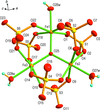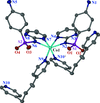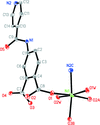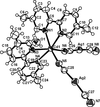issue contents
October 2013 issue

Cover illustration: A view of the [Fe3O(SO4)6(H2O)3]5- unit in tricaesium sodium iron(III) ![[mu]](/logos/entities/mu_rmgif.gif) 3-oxido-hexa-
3-oxido-hexa-![[mu]](/logos/entities/mu_rmgif.gif) 2-sulfato-tris[aquairon(III)] pentahydrate. Displacement ellipsoids are drawn at the 50% probability level. See Mereiter [Acta Cryst. (2013), C69, 1085-1090].
2-sulfato-tris[aquairon(III)] pentahydrate. Displacement ellipsoids are drawn at the 50% probability level. See Mereiter [Acta Cryst. (2013), C69, 1085-1090].
inorganic compounds
Download citation


Download citation


In the title compound, a member of the Maus's salt family, [Fe3O(SO4)6(H2O)3]5− anion complexes are held together by Na+, Cs+ and Fe3+ cations in seven different sites and by five water molecules to form a polar noncentrosymmetric monoclinic structure.
Download citation


Download citation


The structure of Li2Ge4O9 has been determined to show the space group P21ca between 298 and 90 K, thus being in the polar state. A detailed description of structure and temperature variation is given.
metal-organic compounds
Download citation


Download citation


A one-dimensional polymeric structure of CoII with sulfadiazine and 1,3-bis(pyridin-4-yl)propane is further stabilized by intermolecular hydrogen bonding. The structure is of interest with respect to its electrochemical properties in the reduction reaction of H2O2 to H2O. Investigation of the thermal stability shows that the complex is stable up to 543 K.
Download citation


Download citation


The title complex shows a prominent double-stranded ladder-like coordination polymer featuring square-pyramidal geometry around the two CuII centres.
Download citation


Download citation


The chiral stereochemistry and the mer-P and cis-N coordination of the chloridobis[2-(diphenylphosphanyl)ethanamine-κ2P,N](triphenylphosphane-κP)ruthenium(II) cation, [RuCl(PPh3){Ph2P(CH2)2NH2-κ2P,N}2]+, is unique in ruthenium–aminophosphane chemistry.
Download citation


Download citation


In a polymer of 2,5-bis[4-methyl-3-(pyridin-3-yl)phenyl]-1,3,4-oxadiazole (L) with ZnCl2, one-dimensional P (plus) and M (minus) helical chains are formed, where the ligand has different directions of twist. The helical chains stack together via interchain π–π and C—H⋯π interactions.
Download citation


Download citation


The title compound contains a neutral heteroleptic tris-chelate ZnII complex, viz. [Zn(SiF6)(phen)2] (phen is 1,10-phenanthroline), exhibiting approximate molecular C2 point-group symmetry, and represents the first structurally characterized example of a ZnII complex bearing a bidentate-bound hexafluorosilicate ligand.
Download citation


Download citation


The title compound has a metallic cluster structure with a rhomboidal Zn2S2 arrangement. Each ZnII atom is five-coordinated and exhibits distorted trigonal bipyramidal geometry. The structure may be of interest with respect to zinc–thiolate bonds, the coordination chemistry of Schiff bases and the folding of proteins.
Download citation


Download citation


The reaction of metastable aluminum monochloride in the presence of lithium amidinates results in the formation of AlIII amidinates upon heating. Two novel heteroleptic AlIII bis-amidinate chlorides and one homoleptic AlIII tris-amidinate complex are reported.
Download citation


Download citation


A 4-(isonicotinamido)phthalate ligand links NiII centres into a three-dimensional structure with sra topology. The structure is stabilized by N—H⋯O hydrogen bonding between uncoordinated amide groups and extensive O—H⋯O hydrogen bonding between the coordinated water molecules.
Download citation


Download citation


A rare two-dimensional organically templated halocadmate with a novel polymeric anion has been synthesized and characterized. It consists of trimethylsulfonium cations sandwiched between layers of a two-dimensional μ2-chlorido-di-μ2-thiocyanato-cadmate(II) polyanion.
Download citation


Download citation


A three-dimensional polymeric potassium complex incorporating bridging water molecules and 2,4-dicarboxy-5-sulfonatobenzoate ligands forms a one-dimensional inorganic chain with cage-like K4(SO3)2 repeat units. The chains are bridged by carboxylic acid groups to form a two-dimensional layer, and these layers are further linked by carboyxlate groups and benzene rings to generate a three-dimensional framework.
Download citation


Download citation


In the title hydrated mixed cadmium–silver complex, the CdII cation is coordinated by two bidentate 5,5′-dimethyl-2,2′-bipyridyl ligands and two monodentate [AgI(CN)2]− anions, which are in a cis arrangement around the CdII cation, leading to an octahedral CdN6 geometry.
CCDC reference: 960684
Download citation


Download citation


A one-dimensional coordination polymer with a twofold symmetric repeat unit containing three MnII centres. Two different coordination geometries are observed for the two independent MnII metal centres, viz. a distorted pentagonal bipyramid and a distorted octahedron.
CCDC reference: 960121
Download citation


Download citation


The title compound comprises one-dimensional zigzag polymers of MgII cations bridged by isobutyrate groups. The crystal structure is characterized by stacks of hydrophobic (isobutyrate) and hydrophilic (H2O) groups that alternate along the a axis.
CCDC reference: 960018
Download citation


Download citation


The structural evidence for the formation of a cluster-based chain-like polymeric structure incorporating both syn and anti conformers of a flexible dicarboxylate ligand is reported.
CCDC reference: 961456
organic compounds
Download citation


Download citation


The title hydrate salts exhibit similar hydrogen bonding and π-stacking in their crystal structures. The most interesting feature of the hydrochloride salt is the presence of an additional fractional HCl molecule which introduces disorder in the location of the water molecule.
Download citation


Download citation


The conformations of the anilino(phenyl)methyl groups are similar in four related diethyl [(arylamino)(4-ethynylphenyl)methyl]phosphonates. In each compound, the P—C bond has an approximate staggered conformation, with the aniline and ethynylphenyl groups in gauche positions with respect to the P=O double bond, and the two six-membered rings are almost perpendicular.
Download citation


Download citation


The crystal structures of three solvent-mediated lamotrigine–aromatic carboxylic acid complexes exhibit similar hydrogen-bonding motifs and display isostructurality.
Download citation


Download citation


In the title N-protected derivative of gabapentin (Gpn), the molecular conformation is stabilized by intramolecular five- (C5) and seven-membered (C7) hydrogen-bonded rings. The packing of the molecules reveals O—H⋯O and C—H⋯N intermolecular hydrogen bonds, together with π–π interactions.
Download citation


Download citation


Two imidazolium moieties form a homoconjugated cation through a strong and asymmetric O—H⋯O hydrogen bond. In the crystal packing, chloride anions and water molecules are linked via O—H⋯Cl hydrogen bonds, forming an infinite one-dimensional chain.
Download citation


Download citation


Two compounds containing seven-membered heterocyclic rings with 1,2-diaza N atoms have been synthesized and characterized. In each, the C5N2 ring adopts a twist-boat conformation.
Download citation


Download citation


The crystal structures of three new racemic mixed-amide phosphinates are discussed. The compounds crystallize in centrosymmetric space groups and the racemic character is reflected by the symmetry.
Download citation


Download citation


The crystal structures of the oxalate and camphor sulfonate salts of zolmitriptan exhibit two different configurations of the zolmitriptan molecule, which in turn lead to different hydrogen-bonding interactions.
Download citation


Download citation


The structures of the 1:1 hydrated proton-transfer compounds of isonipecotamide (piperidine-4-carboxamide) with oxalic acid and adipic acid are three-dimensional hydrogen-bonded constructs involving several different types of enlarged water-bridged cyclic associations.
Download citation


Download citation


The title compound was analyzed to compare the crystal structure of six-membered-ring azomethines with the five-membered-ring analogues. The structure is driven by intermolecular hydrogen bonding and π-stacking interactions to give the resulting arrangment in the three-dimensional network.
Download citation


Download citation


In the title compound, there are two independent molecules forming hydrogen- and π-bonded dimeric entities with a noticeable noncrystallographic C2 symmetry. Dimers are linked by medium-strength type-I C—F⋯F—C interactions, forming elongated tetramers.


 journal menu
journal menu












































